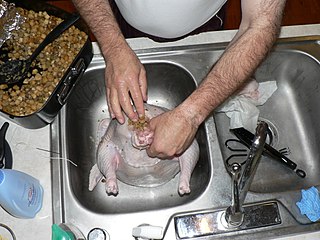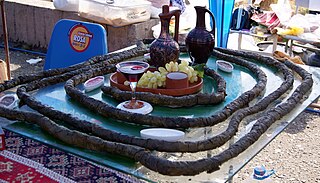
Turkish cuisine is the cuisine of Turkey and the Turkish diaspora. Although the cuisine took its current rich form after numerous cultural interactions throughout centuries, it should not be confused with other cuisines such as Ottoman cuisine or Seljuk cuisine. Turkish cuisine with traditional Turkic elements such as yogurt, ayran, kaymak, exerts and gains influences to and from Mediterranean, Balkan, Middle Eastern, Central Asian and Eastern European cuisines.

Stuffing, filling, or dressing is an edible mixture, often composed of herbs and a starch such as bread, used to fill a cavity in the preparation of another food item. Many foods may be stuffed, including poultry, seafood, and vegetables. As a cooking technique stuffing helps retain moisture, while the mixture itself serves to augment and absorb flavors during its preparation.

A cabbage roll is a dish consisting of cooked cabbage leaves wrapped around a variety of fillings. It is common to the cuisines of Central, Northern, Eastern and Southeastern Europe and much of Western Asia, Northern China, as well as parts of North Africa. Meat fillings are traditional in Europe, and include beef, lamb, or pork seasoned with garlic, onion, and spices. Grains such as rice and barley, mushrooms, and vegetables are often included as well. Fermented cabbage leaves are used for wrapping, particularly in southeastern Europe. In Asia, seafoods, tofu, and shiitake mushrooms or Vegeta may also be used. Chinese cabbage is often used as a wrapping.
Romanian cuisine is a diverse blend of different dishes from several traditions with which it has come into contact, but it also maintains its own character. It has been mainly influenced by Turkish but also a series of European cuisines in particular from the Balkan Peninsula and Hungarian cuisine as well as culinary elements stemming from the cuisines of Central Europe.

Iraqi cuisine is a Middle Eastern cuisine that has its origins in the ancient Near East culture of the fertile crescent. Tablets found in ancient ruins in Iraq show recipes prepared in the temples during religious festivals—the first cookbooks in the world. Ancient Mesopotamia was home to a sophisticated and highly advanced civilization, in all fields of knowledge, including the culinary arts.

Levantine cuisine is the traditional cuisine of the Levant, in the sense of the rough area of former Ottoman Syria. The cuisine has similarities with Egyptian cuisine, North African cuisine and Ottoman cuisine. It is particularly known for its meze spreads of hot and cold dishes, most notably among them ful medames, hummus, tabbouleh and baba ghanoush, accompanied by bread.

Assyrian cuisine is the cuisine of the indigenous ethnic Assyrian people, Eastern Aramaic-speaking Syriac Christians of Iraq, northeastern Syria, northwestern Iran and southeastern Turkey. Assyrian cuisine is primarily identical to Iraqi/Mesopotamian cuisine, as well as being very similar to other Middle Eastern and Caucasian cuisines, as well as Greek cuisine, Levantine cuisine, Turkish cuisine, Iranian cuisine, Palestinian cuisine, and Armenian cuisine, with most dishes being similar to the cuisines of the area in which those Assyrians live/originate from. It is rich in grains such as barley, meat, tomato, herbs, spices, cheese, and potato as well as herbs, fermented dairy products, and pickles.

Sarma, commonly marketed in the English-speaking world as stuffed grape leaves, stuffed vine leaves, or stuffed cabbage leaves, is a food in Turkish, Southeastern European and Greek cuisine made of vegetable leaves rolled around a filling of grains, minced meat, or both. The vegetable leaves may be cabbage, patience dock, collard, grapevine, kale or chard leaves. Sarma is part of the broader category of stuffed dishes known as dolma.
Bosnian cuisine is the traditional cuisine of Bosnia and Herzegovina. It is influenced by Ottoman, Austro-Hungarian and Balkan cuisines.
Armenian cuisine includes the foods and cooking techniques of the Armenian people and traditional Armenian foods and drinks. The cuisine reflects the history and geography where Armenians have lived and where Armenian empires existed. The cuisine also reflects the traditional crops and animals grown and raised in Armenian-populated or controlled areas.

Ottoman cuisine is the cuisine of the Ottoman Empire and its continuation in the cuisines of Greece, Turkey, the Balkans, Caucasus, Middle East and Northern Africa.

Stuffed peppers is a dish common in many cuisines. It consists of hollowed or halved bell peppers filled with any of a variety of fillings, often including meat, vegetables, cheese, rice, or sauce. The dish is usually assembled by filling the cavities of the peppers and then cooking.

Palestinian cuisine consists of foods from or commonly eaten by Palestinians, whether in Palestine, Israel, Jordan, or refugee camps in nearby countries, or by the Palestinian diaspora. The cuisine is a diffusion of the cultures of civilizations that settled in the region of Palestine, particularly during and after the Islamic era beginning with the Arab Ummayad conquest, then the eventual Persian-influenced Abbasids and ending with the strong influences of Turkish cuisine, resulting from the coming of the Ottoman Turks. It is similar to other Levantine cuisines, including Lebanese, Syrian and Jordanian.

Israeli cuisine primarily comprises dishes brought from the Jewish diaspora, and has more recently been defined by the development of a notable fusion cuisine characterized by the mixing of Jewish cuisine and Arab cuisine. It also blends together the culinary traditions of the various diaspora groups, namely those of Middle Eastern Jews with roots in Southwest Asia and North Africa, Sephardi Jews from Iberia, and Ashkenazi Jews from Central and Eastern Europe.

Stuffed tomatoes are one of a number of dishes in which tomatoes are filled with ingredients, usually including rice. In 2017, dolma making in Azerbaijan was included in the UNESCO Intangible Cultural Heritage Lists.

Middle Eastern cuisine or West Asian cuisine includes a number of cuisines from the Middle East. Common ingredients include olives and olive oil, pitas, honey, sesame seeds, dates, sumac, chickpeas, mint, rice and parsley, and popular dishes include kebabs, dolmas, falafel, baklava, yogurt, doner kebab, shawarma and mulukhiyah.

The Dolma Festival in Armenia, also known as Uduli, is an annual festival that is held annually near the city of Armavir, Armenia. It began in 2011 and focuses on appreciation of Armenian cuisine, especially dolma, a traditional Armenian dish made of ground beef, lamb and spices wrapped in grape leaves, cabbage leaves and vegetables.


















